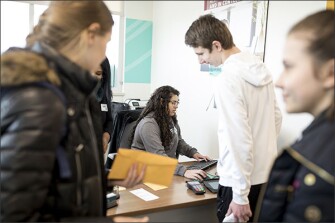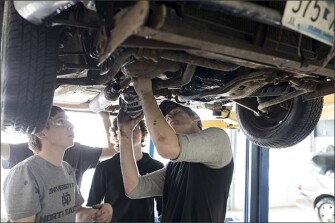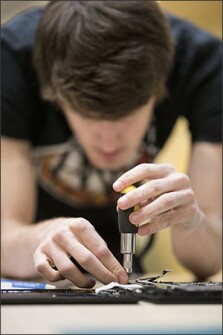Burnsville, Minn.
For schools nationwide, it’s a frustrating and elusive question: How can we help students find a passion that lights up their high school years and guides them into a career? A school in Minnesota thinks it might have found an answer.
It goes something like this: Stop assuming all students should go to four-year colleges. Reorganize your curriculum offerings so teenagers can see clearly how they connect to careers. And partner with 200 businesses—far more than most schools—to infuse real-world work into students’ learning.
The reorganization has changed Burnsville High School from a place where the bachelor’s degree shaped everyone’s thinking to a campus focused on helping all students find a career field that excites them, whether it leads to a four-year degree or not.
The approach is less than two years old. But the school’s leaders are betting big on its potential to keep students from drifting half-heartedly through high school. They’re hoping that a clearer focus—whether it’s a passion for English literature or auto repair—can help students assemble a meaningful, cohesive course of study they can ride into college, work, or more training.
Cindy Amoroso, the superintendent of the Burnsville-Eagan-Savage School District, said she doesn’t want students making post-high-school plans based on unquestioned ideas.
“We want to disrupt assumptions about what comes next after high school,” she said.
Varied Roles
What that’s meant at Burnsville, a school of 2,500 students in the southern suburbs of Minneapolis, has been a huge influx of involvement by local businesses. Most have small- to medium-sized roles, sending experts to talk to students, offering job-shadows, or, in one case, donating leftover metal alloys to be melted down and reused in the school’s fabrication lab.
But some have gotten deeply involved in shaping what goes on at school. Firefly, a local credit union, trained students in basic banking, opened a student-run branch on campus, and helped write a curriculum unit for 9th graders about personal finance.

Justin Jasperse, a senior, started working there eight hours per week after hearing Firefly executives talk in his accounting class about investment strategies and banking careers. He aims for a life in politics, and says that his job at Firefly, where he helps students open checking accounts and learn about budgeting, has helped him learn to “craft my message, to reach people.”
Walser Automotive Group donated $275,000 to turn the school’s old bus garage into a high-tech paradise for engine repair and body work, and has hired five students into full- or part-time jobs. Ryan Wolfe, a senior, brims with pride as he points out welding and tire-balancing equipment at Burnsville High that’s so cutting-edge that most dealerships don’t even have them.
Making his way through the school’s automotive-technology pathway has made Ryan even more sure of his plan after high school: to get his diesel mechanic certification from a technical institute in Florida.
The local cable TV station has its office suite on campus, and staffers teach students how to run the cameras and audio boards. Justin Amaker worked there last year, as a junior, shouldering a camera at off-site events and anchoring the school newscast. Now he’s writing press releases as an intern for the school district. He’s thinking about a career in print or broadcast journalism.
Local nursing homes have provided beds and medical equipment, and the setting for students to accrue clinical hours, all necessary parts of earning certification as certified nursing assistants.
Seeing Courses Differently
The reorganization has also meant rewriting the school’s course catalog, so all elective classes fall into four broad career areas. Within each career area are three or four pathways, and a list of courses relevant to each area.
On a recent afternoon, counselor Ashley Welke met with 9th grader Cheyanne Gorney to review her choice of electives for next year. She listed Preschool lab, Child Psychology 1 and 2, Astronomy, and Human Anatomy. Welke gently probed to see if this was a random sampling, or part of a cohesive strategy.
Cheyanne explained that she wants to write science fiction, and also teach science to support herself. They discussed creating room for a creative-writing course, and for prerequisites to a new multicultural-education offering. They agreed to review the course plan next year. “Nothing’s ever set in stone,” Welke says.

There are no national figures on how many partnerships businesses have with schools, but experts agree that Burnsville has far more than most. And the school has something else few schools have: a staff member whose main job is to create and support those partnerships.
Kathy L. Funston worked for six years as the district’s curriculum director, but she changed roles as the district began a review of its mission two years ago. Burnsville, the district’s only high school, had 30 business partners two years ago. Funston has delivered a sevenfold increase since then.
On a recent morning, Funston and Burnsville High Principal Dave Helke met with the city’s fire chief and community college leaders to work on designing a new pathway for students to earn certifications as emergency medical technicians.
The next day, she gathered at the chamber of commerce with business leaders who are co-facilitating a new, five-session after-school program that will confer certificates showing that students have mastered workplace skills, such as reliability.
Some of those same businesses are also working with Funston and Helke to create a summer “externship” to bring Burnsville teachers into their workplaces to give them ideas about infusing real-world work skills into core courses.
‘The Secret Sauce’
Kate Kreamer, the deputy executive director of Advance CTE, a group that represents state career-technical-education directors, said it’s rare that schools carve out a position like Funston’s, but more are starting to do so.
“We’ve never seen business partnerships sustained at scale without having someone whose job it is to think about them and make them happen,” she said. “It’s the secret sauce.”

Close relationships between schools and businesses can create questions, however. Alex Molnar, a research professor at the University of Colorado-Boulder, and the director of the Commercialism in Education center there, believes schools must answer a central question before allowing business partners to shape what goes on in classrooms.
“Is this something you want your students to be doing, even in the absence of a business partner?” he asked. “If the answer is yes, that’s a good starting point. If it’s no, that’s a warning flag.”
Funston is confident that Burnsville’s partnerships are grounded firmly in what’s best for students.
“We still own the curriculum,” she said. “We don’t turn over the reins and say ‘Teach what you want.’ We still have to teach our academic standards. What these businesses can add is the practical application of the content.”
At Firefly, about 150 students have opened accounts since the on-campus branch opened a year ago, said Martin J. Kelly, its senior vice president for marketing. The aim of the partnership wasn’t about profit—“if we opened that branch for profit, we’d be kidding ourselves,” he said—or branding, although the campus branch window bears a version of the credit union’s logo, “Life Illuminated.”
The credit union’s partnership with Burnsville sprang from a desire to build a base of financial literacy in young people, Kelly said. A “delightful byproduct” of the project has been hiring eight students to work part-time for the credit union, he said.
Rethinking Priorities
That link to real-world work is one of the things Burnsville leaders prioritized when they reworked their school two years ago. They realized they offered few options for students who didn’t want four-year degrees. College dropout and remediation rates suggested that college-bound students weren’t flourishing after high school. In a swirl of community meetings and surveys, families said they wanted good rigorous classes, but with more real-world, career-oriented planning and experience.
After a big outreach campaign in 2015, the Burnsville community—where half of students come from poverty—approved a $64 million bond levy for facilities and equipment, and a $25 million levy over 10 years for technology. The money allowed Burnsville High to add 150,000 square feet of space to its building, decked out with state-of-the-art equipment and flexible classroom spaces. Re-envisioning the course catalog and career pathways were part of that project.
The high school has commissioned an independent, seven-year evaluation of its pathways work. That project is only in its second year, but preliminary results show a mixed bag. Four in 10 students report that the approach helps them focus better on career ideas. But 6 in 10 didn’t even try career-pathways courses, and nearly one-third of those who did say they weren’t that interesting or exciting.
School leaders don’t yet know the racial or socioeconomic breakdown of students by pathway, a key unanswered question for school leaders who want to disrupt, not replicate, old vocational-education tracks that relegated some students to dead-end, low-paying jobs.
As the pathways approach develops, it generates questions for students that can be as valuable as the answers. Sundus Farah, a junior, is taking classes to earn her credential as a certified nursing assistant, but that might be just her first step.
Sundus harbors a passion for ophthalmology, and might want to go on to medical school. Meanwhile, she says she’s “sampling” the offerings in the school’s medical pathway. “I like that I can test it out while I’m still in high school,” she said. “I have friends who went to college and it was a disaster,” with dropouts and costly time spent trying to figure out a direction. She wants to avoid those mistakes.
Emma Hovde found clarity in a 9th grade introduction-to-programming course: She hated it. But she found her calling in a marketing class that same year. She got really excited working with Firefly on the finance curriculum, and on the credit union’s marketing campaign to launch the campus office. Now in 10th grade, Emma lights up as she talks about her plans for a career in business or finance.
“It’s great to have a real-world situation when I’m figuring it out,” she said. “When you’re doing that actual thing that you’re learning [in school], you realize, ‘Oh, that’s what I want to do.’ Or you realize, ‘No, it’s not.’ And that’s just as important.”






